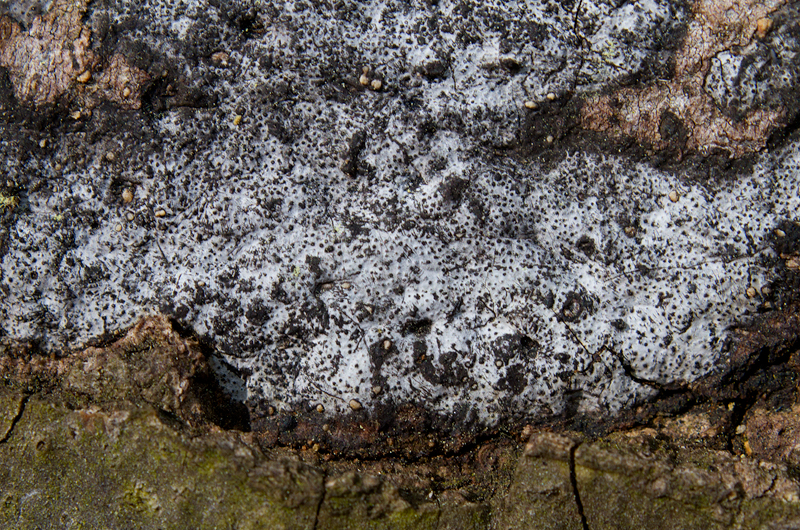Map Snapshot






















345 Records
Status
Biscogniauxia atropunctata is a fungus that attacks hardwoods and causes the Hypoxylon Canker of Oak or Biscogniauxia Canker and Dieback disease, which often causes death to an infected tree. According to the Oklahoma State University Cooperative extension, "The fungus colonizes healthy trees and lives in the bark and sapwood for an indefinite period of time without causing damage. In healthy trees, natural defenses are typically present that prevent the fungus from causing disease. When the tree becomes stressed, its defenses are reduced and the tree can no longer resist the fungus. Stress factors include drought, heat, root damage, chemical injury and other diseases. Trees that are attacked by defoliating insects are also more likely to develop Biscogniauxia dieback."
Description
Gray-white smooth sheet with black dots (J. Solem, pers. comm.).
Relationships
According to the Oklahoma State University Cooperative extension, "Although all oak species are susceptible, the disease is more frequently observed on the red oak subgroup...Biscogniauxia canker and dieback can be found on maple, hickory, Pecan, Goldenrain Tree and sycamore (Platanus spp.)"
Seasonality Snapshot
Source: Wikipedia
| Biscogniauxia atropunctata | |
|---|---|

| |
| Scientific classification | |
| Domain: | Eukaryota |
| Kingdom: | Fungi |
| Division: | Ascomycota |
| Class: | Sordariomycetes |
| Order: | Xylariales |
| Family: | Graphostromataceae |
| Genus: | Biscogniauxia |
| Species: | B. atropunctata
|
| Binomial name | |
| Biscogniauxia atropunctata | |
Biscogniauxia atropunctata, the hypoxylon canker, is a species[2] of sac fungus in the family Graphostromataceae. Like many other fungi in the genus, it is a plant pathogen; specifically this species can cause Biscogniauxia (Hypoxylon) canker and dieback disease in host trees.[3][4]
Taxonomy
[edit]Biscogniauxia atropunctata contains the following varieties:
Description
[edit]Patches of the fungus can reach a few metres across. It is white, sometimes with black patches, and usually with a black margin.[5]
Similar species
[edit]In addition to other species within the genus, Diatrype stigma, Camarops tubulina, Kretzschmaria deusta, and species of Camillea can appear similar, as can Arthonia lichens.[5]
Distribution
[edit]This species is found in spring and early summer east of the Rocky Mountains of North America.[6]
Ecology
[edit]When not pathogenic, Biscogniauxia atropunctata is saprobic on oak and other hardwood trees, causing a white rot on the host deadwood. The fruiting body grows in patches with a whitish-gray surface covered by black dots that grow to be blackened overall.[6]
The fungus can colonize healthy trees and live undetected and harmlessly in the bark and sapwood for some time, its spread kept in check by the host's natural defenses. However, when the trees become stressed, the fungus invades weakened host tissues, causing the dieback disease. Initially the infection kills affected branches, then progresses down the trunk to form a canker, girdling the tree and killing the entire crown.[4]
References
[edit]- ^ Pouzar, Z. (1979). "Notes on taxonomy and nomenclature of Nummularia (Pyrenomycetes)" (PDF). Česká Mykologie. 33 (4): 216.
- ^ a b c "Biscogniauxia atropunctata (Hypoxylon Canker)". iNaturalist. Retrieved 2023-05-08.
- ^ "Hypoxylon canker of oak". The University of Georgia - Center for Invasive Species and Ecosystem Health. Retrieved 2023-05-09.
- ^ a b Jennifer Olson (February 2017). "Biscogniauxia (Hypoxylon) Canker and Dieback of Trees". Oklahoma State University Extension.
- ^ a b Audubon (2023). Mushrooms of North America. Knopf. p. 78. ISBN 978-0-593-31998-7.
- ^ a b Michael Kuo (April 2019). "Biscogniauxia atropunctata". MushroomExpert.Com.

















